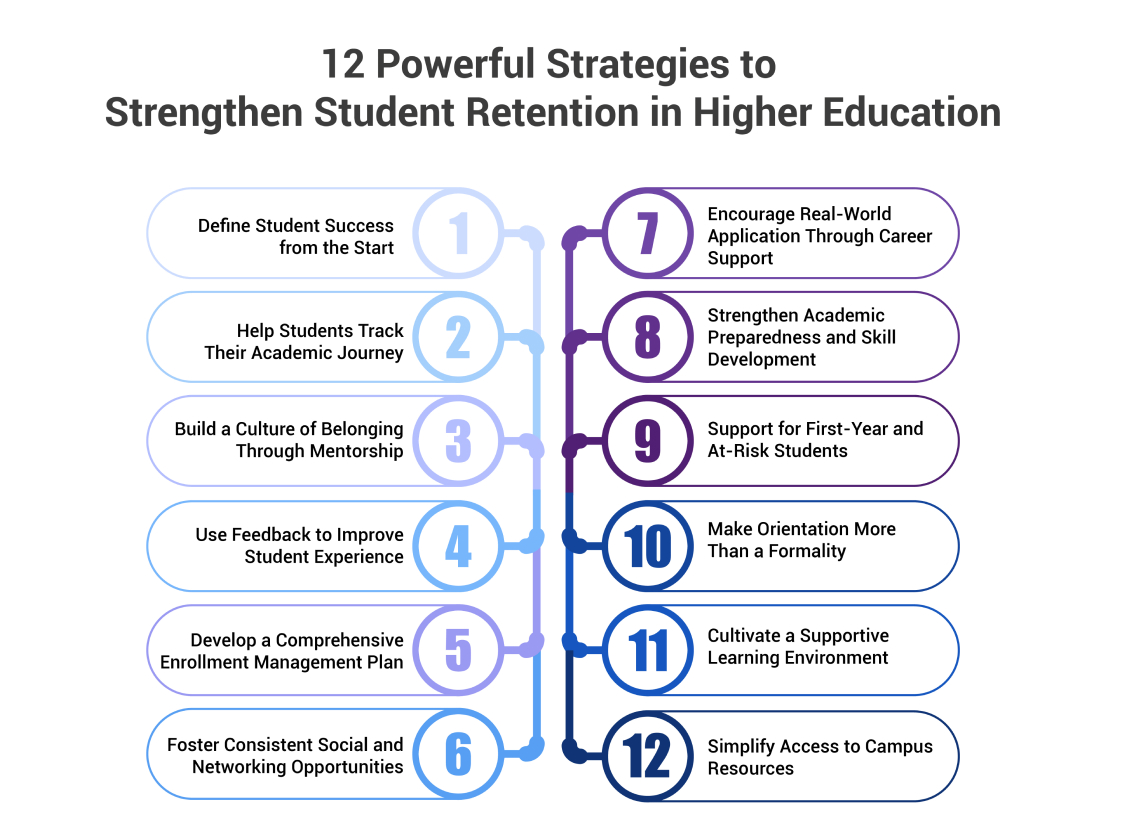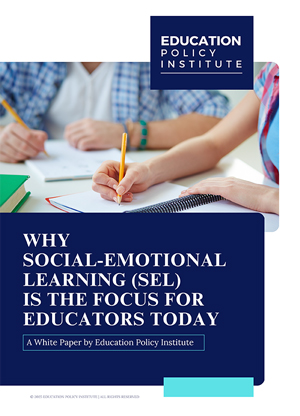When a student walks away from college, the cost is more than just a number. For them, it’s often lost time, rising debt, and limited future prospects. For institutions, it’s a missed opportunity and a disruption to the student success story they strive to build.
Today’s academic landscape makes one thing clear—retention isn’t just a metric, it’s a mission. With rising tuition, shifting student expectations, and mounting pressure to deliver value, colleges and universities must take proactive steps to keep learners on track.
To effectively retain students, universities must recognize that engagement extends beyond just the classroom. It requires building strong relationships with students, offering personalized support systems, and ensuring they feel part of a thriving campus community. Addressing both academic and emotional needs is key to creating an environment where students feel motivated to succeed.
Institutions also need to move beyond a one-size-fits-all approach. With diverse student populations, better retention strategies—such as targeted outreach to at-risk students or offering flexible learning options—can play a critical role in ensuring that students not only stay enrolled but remain committed to completing their education.
Why Student Retention is Necessary in Higher Education?
Student retention in higher education is the ability of institutions to keep students enrolled throughout their academic journey until graduation. It is a significant measure of both student satisfaction and institutional success, influencing a school’s reputation and funding. When students remain in their programs, they are more likely to graduate, enter the workforce with relevant skills, and contribute positively to society. Therefore, universities must understand the factors that impact retention to maintain a high enrollment rate and ensure continued academic success for students.
Several factors can influence whether a student stays or leaves. Personal struggles, such as financial challenges, health issues, or difficulty adjusting to campus life, are some of the leading causes. Academic difficulties also contribute, with students who lack preparedness or face challenges in coursework often considering dropping out. Additionally, factors like program dissatisfaction, feeling overwhelmed by workload demands, or making the wrong program choice can contribute to student attrition. To improve retention rates, higher education institutions must identify these barriers and implement strategies that enhance the student experience, provide academic support, and nurture a welcoming campus environment that encourages long-term engagement.
Challenges of Student Retention in Higher Education
Student retention in higher education remains a persistent challenge, influenced by a complex interplay of academic, financial, and social factors. Despite efforts to improve graduation rates, many institutions continue to struggle with keeping students enrolled through to course completion. One significant barrier is financial hardship. The rising cost of tuition, coupled with living expenses, often forces students to pause or abandon their studies. This issue is particularly acute among underrepresented groups, who may lack access to adequate financial aid and support systems.
Academic preparedness also plays a crucial role. Students entering college without the necessary academic skills may find themselves overwhelmed by coursework, leading to frustration and eventual withdrawal. Institutions that fail to provide sufficient academic support services, such as tutoring and mentoring, risk higher dropout rates.
Social integration is another critical factor. Students who feel disconnected from their campus community are more likely to leave. A sense of belonging has been identified as a key component in student retention, emphasizing the need for inclusive environments and supportive peer networks.
Moreover, institutional factors such as complex administrative processes and inadequate communication can exacerbate student attrition. When students encounter bureaucratic hurdles or feel that their concerns are not addressed, their commitment to the institution may wane.
Tackling these issues calls for a comprehensive strategy involving monetary aid, educational support, and the creation of an inclusive, supportive campus environment. By identifying and addressing the root causes of student attrition, colleges and universities can boost retention rates and promote long-term student achievement.
12 Powerful Strategies to Strengthen Student Retention in Higher Education
Student retention remains a key priority for higher education institutions. Successfully guiding students from enrollment to graduation demands a strategic and student-centered approach. Every phase of the academic journey offers an opportunity to deepen student commitment and address potential dropout triggers. The following strategies are designed to build long-term engagement and academic success.

- 1. Define Student Success from the Start
Students thrive when they have a clear understanding of what success looks like. Institutions must lay out academic expectations, key milestones, and graduation requirements early on. When students understand the roadmap, they’re more motivated and confident in their ability to meet those expectations.
- 2. Help Students Track Their Academic Journey
Clear progress indicators reduce anxiety and enhance motivation. Digital tools like academic dashboards, co-curricular pathways, and structured goal tracking give students visual clarity on how far they’ve come and what remains. This ongoing sense of progress encourages persistence and keeps long-term goals in sight.
- 3. Build a Culture of Belonging Through Mentorship
Establishing strong peer and faculty connections creates emotional support and guidance. Structured mentorship—whether through senior students, alumni, or academic advisors—can help new students navigate challenges, feel heard, and remain committed to their studies. These bonds often serve as emotional anchors during difficult times.
- 4. Use Feedback to Improve Student Experience
Actively collecting student feedback shows learners that their voices matter and drives continuous improvement. Even when every issue can’t be resolved immediately, acknowledging concerns and communicating changes builds trust. Students are more likely to stay when they feel their input shapes the campus environment.
- 5. Develop a Comprehensive Enrollment Management Plan
Retention begins long before classes start. Strategically targeting students who align with your institution’s values and offerings, supporting them with orientation programs, and providing adequate financial aid can improve their commitment from day one. A well-planned enrollment process creates a smoother, more confident transition into academic life.
- 6. Foster Consistent Social and Networking Opportunities
Human connection plays a huge role in student persistence. Hosting regular mixers, interest-based events, and professional networking opportunities helps students form meaningful bonds with peers, mentors, and future employers. A connected student is often a committed one.
- 7. Encourage Real-World Application Through Career Support
Linking academic experiences to future career paths gives learning greater relevance. Offer career counseling, resume workshops, internship placements, and job fairs that help students visualize how their education translates into employment. When students feel their studies are building toward something concrete, they are more likely to persist.
- 8. Strengthen Academic Preparedness and Skill Development
Early academic struggles are one of the most common reasons students drop out. Provide foundational support through remedial courses, study skill workshops, writing centers, and tutoring programs. Strengthening academic confidence increases students’ ability to succeed and remain enrolled.
- 9. Support for First-Year and At-Risk Students
Transitioning into higher education can be overwhelming. Dedicated support programs for first-year and at-risk students—such as bridge programs, advising check-ins, or peer-support groups—can help them acclimate socially and academically. Early intervention can significantly improve long-term retention.
- 10. Make Orientation More Than a Formality
A dynamic and extended orientation period can set the tone for the entire academic journey. Go beyond campus tours and schedules by including workshops on academic expectations, campus resources, mental wellness, and social integration. This helps students begin their studies feeling informed, included, and empowered.
- 11. Cultivate a Supportive Learning Environment
Students are more likely to remain enrolled when they feel encouraged and supported. Institutions should train faculty in inclusive teaching practices, provide mental health services, and ensure classroom environments are respectful and engaging. A supportive culture nurtures resilience in students.
- 12. Simplify Access to Campus Resources
Sometimes, students leave simply because they don’t know where to turn for help. Make academic, emotional, and financial support easy to find through centralized platforms, clear communication, and proactive outreach. The fewer barriers students face, the more likely they are to stay and succeed.
Conclusion
Student retention is a critical aspect of higher education that goes beyond institutional metrics—it reflects the quality of support, engagement, and inclusivity offered to learners. As challenges such as financial pressures, academic difficulties, and personal struggles continue to affect students' ability to persist, institutions must respond with innovative, student-centered strategies. From building strong mentorship networks to offering flexible learning pathways and responsive support systems, the goal is to create a campus environment where every student feels valued, supported, and motivated to complete their educational journey. When retention becomes a shared responsibility across all levels of an institution, it not only leads to higher graduation rates but also contributes to a stronger, more equitable future for higher education.





